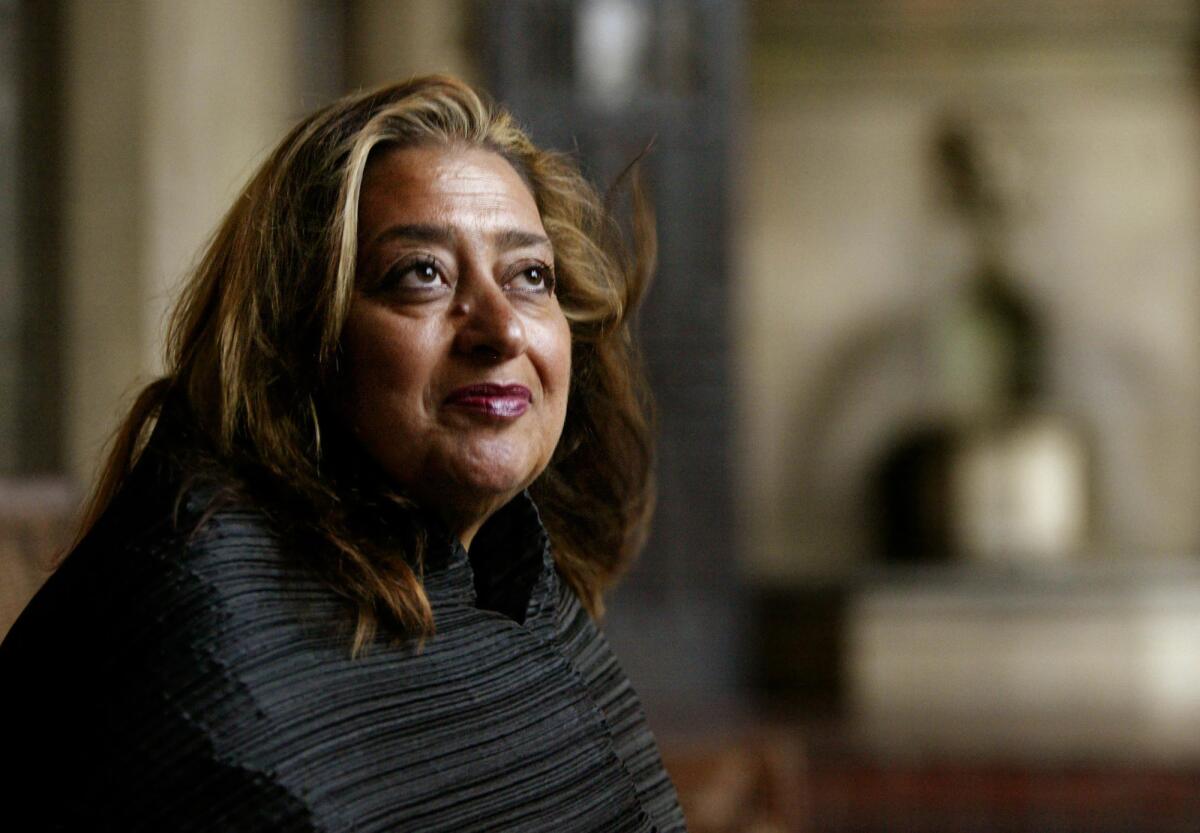From the Archives: Architect Zaha Hadid becomes first woman to win Pritzker Prize

Iraqi-British architect Zaha Hadid in West Hollywood in 2004.
In 2004, Iraqi-British architect Zaha Hadid became the first woman to win the Pritzker Prize. Hadid died March 31, 2016. Here’s our story from March 22, 2004, when she accepted architecture’s top honor:
Zaha Hadid, whose dynamic designs often seem to defy laws of gravity, has won the Pritzker Prize, architecture’s highest honor. It is the first time the prize has been given to a woman in the award’s 25-year history.
Based in London, Hadid has long been considered one of architecture’s most precocious talents. Her exquisite architectural renderings -- many created while she was in her 30s -- made her an international cult figure before she had completed a single building. Taut with energy, their delirious arrangements of color recalled the works of Futurist painters such as Umberto Boccioni, and they suggested a new kind of urban landscape, one set in a perpetual state of motion.
But it is only in recent years that Hadid has landed the kind of high-profile international commissions that could legitimize her place among architecture’s elite. Among the most striking is the recently completed Rosenthal Center for Contemporary Art in Cincinnati, Hadid’s first built project in the United States. The structure’s chiseled concrete exterior evokes a collection of urban fragments that has somehow broken free of the surrounding cityscape.
Other recent built works include a tram station and parking lot in Strasbourg, France, and a soaring ski jump in Innsbruck, Austria. She is completing a science center in Wolfsburg, Germany, a Center for Contemporary Art in Rome and an arts center in Bartlesville, Okla.
Pritzker juror Ada Louise Huxtable wrote that “Hadid’s fragmented geometry and fluid mobility do more than create an abstract, dynamic beauty; this is a body of work that explores and expresses the world we live in.”
Hadid was clearly surprised by the selection. “Things have changed so much in the past few years,” she said during a recent trip to Los Angeles. “We have been doing a lot of public work; we’re doing big urban projects in China and Bilbao. Even so, it’s hard to say what effect [winning the prize] will have. It hasn’t really hit me yet.”
Hadid was born into a prominent Iraqi family in Baghdad in 1950. Her father, an industrialist, was a founder of the National Democratic Party. It was a time when Iraq was particularly open to the West, and its institutions and the Middle East in general were eager to embrace modernity.
Even at an early age, Hadid knew she wanted to be an architect. “There were many modern buildings going up then in Baghdad,” she remembers. “And my father was very interested in architecture. Our house was one of the first modern houses in the city. By the time I was 11, I had designed all of the furniture for my room.”
But it was at London’s Architectural Association School of Architecture that Hadid’s creative voice began to truly emerge. At the time, a rising group of young visionaries was growing disillusioned with the increasingly dogmatic formulas of late Modernism. Hadid, like many of them, was drawn to the works of the early Soviet artists and architects, in particular the weightless abstractions of Kasimir Malevich.
“I had gone to Moscow in 1978,” she recalls. “I found in Malevich’s Suprematist paintings a new way to think about the organization of the plan. It was this idea of the city as a series of collisions -- and also as a continuous field rather than a collection of independent objects.”
Her breakthrough came in 1982, when she won a competition for a country club in Hong Kong. Dubbed “The Peak,” the project’s fragmented forms, perched on Victoria Peak with a sweeping view of the city below, were organized as a series of horizontal beams. The beams’ intersecting forms projected out from their site, as if they were about to shoot off into space.
The design’s audacity stemmed from its refusal to treat the club as an isolated object. Instead, Hadid’s paintings represented a radical reinterpretation of the entire city, one in which the traditional urban grid was replaced by a landscape in a constant state of motion.
That notion also was reflected in the design’s structure, which evoked conventional freeway construction.
Yet the images were so fantastic that many doubted that the project could be built. And Hadid would struggle for years before the ideas she was able to express so powerfully on canvas were translated into actual buildings.
When she did build, her work revealed a subtle grasp of structural issues and a deft understanding of material. Her 1993 Vitra fire station, built for a private furniture company in Germany, was marked by a triangular canopy propped up on a cluster of slender steel columns. Seen from one angle, the building’s exterior -- a composition of horizontal concrete planes -- seemed about to break apart. From another, the building looked like a concrete bunker. The tension gave the project a visual complexity that was startling.
In recent years, Hadid has been able to explore such formal issues with greater depth. The interlocking concrete-and-steel forms of the Rosenthal Center for Contemporary Art, for example, are a clear reference to Malevich’s Suprematist compositions. But the fluidity of the structure’s interior spaces is clearly rooted in current architectural sensibilities. By lifting the galleries up on slender columns, Hadid allows the surrounding street life to slip through to the back of the building, where it rises along a narrow vertical slot of crisscrossing ramps that leads into the various galleries.
Hadid has called this her “urban carpet,” and its aim is to create a seamless connection between public and private zones, between the vibrant social activity of the city and the more contemplative world of art. The result is a remarkably nuanced psychological experience, one in which the visitor glides along in a kind of sensual dream.
Other recent projects express a similar desire to break down conventional boundaries. A ski jump in Innsbruck rises out of its Austrian mountainside site like the arched body of a cobra. A restaurant is perched near the top of the ramp so visitors can watch skiers glide off in midair toward the horizon. A design for a car park and tram station in Strasbourg, France, is composed with such delicacy that it seems to dissolve into its suburban setting.
Such projects are imbued with a subtle social message. In all of her works, Hadid seems to be striving for both intimacy and freedom. The public realm, once clearly prescribed, becomes more fluid. Traditional hierarchies are demolished.
“A lot of this came out of the idea that you don’t have a privileged site, that these spaces should feel open to everyone,” Hadid says. “It was a move away from the fortress, the wall, from the idea of elitism. So our idea was always to create layers of public space, to multiply the ground condition. Eventually, the building and the ground became one piece.”
It may be that Hadid’s best work lies ahead of her. In the last few years, the architect has seen an explosion of major commissions that range in scale from a house overlooking the Pacific Ocean on the outskirts of San Diego to a master plan for a large-scale urban development near Singapore. Among the most promising projects under construction is the BMW Central Building, a 270,000-square-foot office and manufacturing plant in Leipzig, Germany. Conceived as a series of interweaving strands, the structure’s sinuous concrete forms suggest a hybrid of natural and mechanized landscapes. It is a radical reworking of the rigid assembly-line systems that once fascinated the early Modernists.
In her Singapore master plan design, Hadid expands these ideas to the scale of a city. An enormous undulating “urban carpet” evokes shifting geological plates. A distorted urban grid is carved through this form, breaking them down into a series of smaller urban blocks.
Such projects point to Hadid’s remarkable imaginative range. And they hint at the reason she has become such a powerful force in contemporary architecture. Hadid’s formal language is rooted in the increasing fluidity of our postindustrial world. Yet unlike many of her peers, who have grown up fluent in emerging computer technologies, she invests these forms with social and psychological meaning. Her best works echo some of Modernism’s earliest themes while pushing them forward in ways that seemed unimaginable a generation ago.
The award will be presented at a ceremony at the Hermitage Museum in St. Petersburg, Russia, on May 31. It comes with a $100,000 prize.
More to Read
The biggest entertainment stories
Get our big stories about Hollywood, film, television, music, arts, culture and more right in your inbox as soon as they publish.
You may occasionally receive promotional content from the Los Angeles Times.










